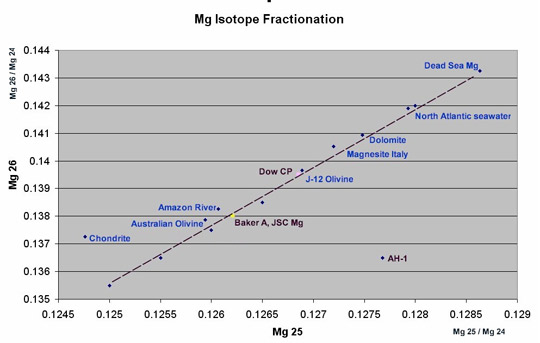In a recent email he offered comment about an article, Test confirms Roswell debris is not from Earth, published by Open Minds (not to be confused with Open Minds Forum):
The article was written by Alejandro Rojas and explored the work of Frank Kimbler, a teacher in Roswell. It seems Kimbler found some debris, suspected it may be from the famous crash, and subsequently had the debris analyzed.
As can be gathered from the title of the article, Rojas suggested no further analysis is necessary and that the debris is certainly “not from Earth.” Frank Purcell offered some contradicting peer review, the gist of which is that Rojas' claims are premature. With Frank's permission, I post his comments:
The chart below, taken from the article, plots the ratio of isotopes Mg26/Mg24 vertically against the ratio of isotopes Mg25/Mg24 on the horizontal axis. The sample of metal analyzed from Roswell is shown by AH-1 that is clearly not on the line of the other samples. The line represents the spread of Mg26 relative to Mg25, the two minor isotopes, each nominally 10% compared to the more abundant isotope MG24 that is roughly 80% of earthly magnesium.Presenting the data in this manner without error bars is deceptive because it suggests the AH-1 sample has non-earthly isotope ratios - the conclusion intended by the thrust of the article.
The data points on the line are presumably from many analyses of many samples by many different laboratories. Properly, error bars, typically of 1 standard deviation, should be shown and would be if this were an article in a scientific journal. Even though we don't have that information, we do have an error analyses for the AH-1 sample, as follows:
Isotope Abundance - observed Abundance - naturalMG24 79.1 +/- 0.5 78.6MG25 10.1 +/- 0.5 10.1Mg26 10.5 +/- 0.5 11.3
I assume the error estimate of +/- 0.5 represents 1 standard deviation for each analyses. Note that MG24 analyses falls within expectations for natural abundance, i.e., 78.6 to 79.6 where the expected mean is 78.6 . Similarly, Mg25 is at the expected level. MG26, within 1 standard deviation, however, is not at the expected 11.3%, but is estimated to be in a range between 10.0 and 11.0 . Is this significant? We can't say for sure. We can statistically argue that the measured 10.5 +/- 0.5 really has a mean of 11.3 with a probability of 11% using the normal distribution table. But that 11% probability, although small, assumes perfect knowledge that the true mean is 11.3, and this we don't know because no error estimate is given for the accepted value.
The data is presented and plotted as isotopic ratios. Although AH-1 is shown as a point, it is really an area on the chart extending from 0.120 to 0.135 on the horizontal axis and from 0.125 to 0.140 on the vertical axis. (These ranges are calculated from the observed data.) It is clear that this range does in fact intersect the line and is suggestive that the AH-1 sample is not extraterrestrial.
I would also like to see Open Minds or others follow up on the Kimbler debris, eventually giving us the rest of the story. One way or the other, I appreciate Frank offering qualified peer review. Ufology could use more of this kind of analysis of such circumstances and those who report them.Sure, additional measurements would be helpful to discern if the metal is terrestrial, or not. Hopefully, Open Minds will publish additional results when they are available.

> I would also like to see Open Minds or others follow up on the Kimbler debris, eventually giving us the rest of the story.
ReplyDeleteThey've got the answer they like Jack, and are sticking to it. Here's a snippet from a June 22 2012 article:
"New Mexico Military Institute teacher Frank Kimbler also discovered metal fragments in this area in 2011. Initial tests on those fragments concluded that 'either the lab made an analytical error or the material is not from Earth.'"
http://www.openminds.tv/james-fox-hints-at-new-evidence-related-to-the-roswell-ufo-crash-964/
Last year, Kevin Randle quoted Kimbler as saying: "The media hyped the hell out what I said but at least they said some important things. One data set with results at the limit of the margin of error does not make for
alien spacecraft." Kimbler was hopeful but a lot more cautious than Open Minds.
http://kevinrandle.blogspot.ca/2011/09/roswell-and-disappearing-debris.html
Hey, Terry -
ReplyDeleteI never held much hope that the debris would prove to be extraterrestrial, but I was hoping it could offer some clues as to what man-made craft might have actually gone down out there. It might have been pretty interesting, for instance, if testing could have confirmed the age of the debris. Similar details might then be correlated, allowing further research to identify and eliminate various possibilities. Ultimately, I thought it would indeed be interesting if it could have been reasonably established that the debris came from, say, a 1940's wing craft or such.
Actually, I thought the prevailing lack of discussing such possibilities as the story made the rounds was interesting in itself. In other words, while all the talk was about determining if the debris was from outer space, no one seemed to care (or _want to know_) what it was if it was man-made!